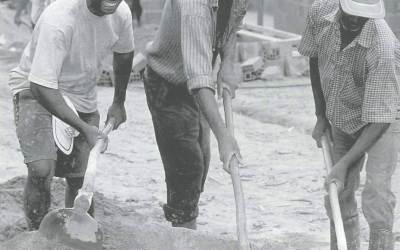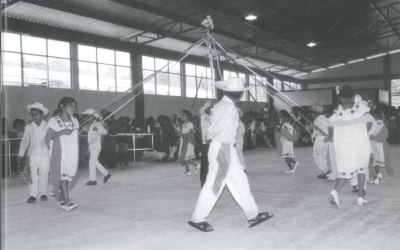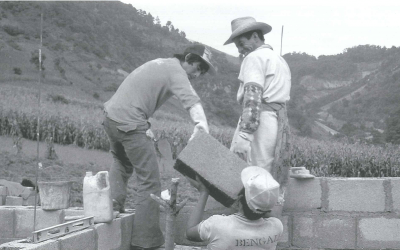Philanthropy In Brazil
A modern democratic society is incomplete without an independent non-profit sector that functions in cooperation and at times in competition with the two major sectors of business and government.
( David Rockefeller keynote speech at the Rio Seminar on Citizen Participation, 1993)
It seems like a long time ago. So much has changed in the world of philanthropy. I was organizing a seminar on the subject in Rio de Janeiro, and debated with David Rockefeller and other leaders on finding the appropriate title.
The original concept was to hold a seminar on Philanthropy, a subject we felt was not properly understood in my country. Whereas in North America, the word has a clear and well-understood meaning of promoting human welfare, in Brazil there was no such clear understanding. Indeed, in many cases, the word was used in a deprecatory way in connection with self-serving actions by those who took advantage of tax and other government benefits without producing the social benefits they claimed.
We finally called the seminar Citizen Participation, with the evocative subtitle Social and Cultural Responsibility in a Democratic Brazil. David Rockefeller delivered the keynote speech at that seminar nine years ago, emphasizing the important role of philanthropy in the discussion and definition of the importance of citizen participation. The seminar marked a turning point in understanding citizen participation as integral to dealing with the problems of poverty and inequality in Brazil and in creating the quality of life to which all Brazilians aspire. Philanthropy in its most traditional sense is nothing new to Brazil. The concept of Charity has been clear and a strong component of our culture since colonial times. Many Brazilian cities, including Rio, still have major hospitals called Holy Houses of Mercy, mostly run by Sisters of Charity and maintained by citizen donations. To act charitably towards the poor and needy was always a good Catholic’s obligation (although not always followed with proper diligence). However, it is important to realize that charity was basically a religious obligation, rather than a civic one. The object was to save the individual soul, not the collective city. The latter was the exclusive responsibility of government: the King, the Emperor, the multiple Presidents (more or less authoritarian) and since 1960, an abstract concept translated into the word–Brasilia, the central government.
Most citizens and much of the Brazilian press perceived the government as the solely responsible party for providing the common good and advancement of the Nation. And this perception became the focus of the discussions at the groundbreaking 1993 seminar.
In the opening statement, framing the event’s conceptual basis, I emphasized, “The purpose of this seminar is to affirm that in order for our country to achieve the future which we all hope for and overcome the crossroads of the present, it is necessary to have decisive and growing action on the part of its citizens, that they stake out the objectives and the outline of the nation that they desire and that they work for it, giving it their time, money and dedication, each within his possibilities, in order to make certain that it comes to be in the real world, instead of remaining just a dream passed on from generation to generation.” Nearly ten years have gone by since those memorable discussions took place among representatives of all sectors of Brazilian life and culture. Since then, the concepts of philanthropy, citizen participation and third sector in Brazil have taken root and expanded in a truly remarkable way.
Brazil entered the new millennium with significant improvement in its social indicators. From 1991 to 2000, adult illiteracy fell from 19.7% to 12.8% of a population, which grew from 146.8 million to 169.8 million. Population growth, which averaged over 2.5% a year from 1950 to 1980, dropped dramatically in the last decade, to an average of 1.64%. At the same time, household income has grown by 42% in the decade. The Gini index (which measures inequality) fell from 0.637 to 0.609, which, although still very high, reflects a move in the right direction, particularly if one considers that in absolute numbers the population grew by some 23 million people in the period.
With more than 170 million people, Brazil today has the fifth largest population among the countries of the world (behind China, India, the U.S. and Indonesia). It is still a very young country with 58% of its population under 30 and 30.6% under 14 years old. It should be noted that 97% of school-aged children are actually going to school, a substantial gain from past years.
Notwithstanding all the good news emerging from the 2000 census,, stark realities still have to be faced: Brazil is a poor and unequal country. Half of its 44.7 million heads of family earn less than US$230 per month and the poorest 50% share 12% of the country’s income. The task to be faced (hopefully without neglecting the soul) continues to be to save the city.
Nevertheless, inequality as a static condition does not reveal much about the potentials of a society. A theoretical country where all the population is equally and miserably poor is not better off (although much less unequal) than its neighbor where half the population is miserable and half is rich. The latter is a much less just country (as President Cardoso once said of Brazil) although its potential for becoming a rich and just country is immensely greater. The challenge faced by Brazil is to convert the problems of inequality and poverty into the opportunity of growth and well-being.
The last decade has proven that both Government and Citizens (including the Business Community and the Third Sector) can contribute to this end, so long as each realizes the extent and limitations of its role. Since the early 90s, the Brazilian government–as well as business and citizens in general–have taken great steps towards readjusting their respective roles. The government has reduced its scope of action through decentralization and privatization, as well as giving support to citizen activity and the third sector. Business has not only invested and thereby created jobs and riches, but also has increased consciousness of its social obligations towards the community in general and its own employees in particular. Finally, citizens have become more aware of their own responsibility and power to influence their lives and that of their neighbors and communities.
Private philanthropy, in the North American sense, has continued to grow, with rich individuals donating scholarships and endowing new foundations and institutes in the areas of education, health and culture. However the most innovative activities towards facing the challenges of participating citizenship are being taken by two extremes: the business corporations and the small communities of citizens congregating around a common interest.
At the time the Citizen Participation seminar took place, the 1917 Civil Code was still governing the creation and operation of foundations in Brazil. When the Code was written, foundations were mainly confined to much-restricted field of action within family law. Although, by 1993, a large number of foundations existed, only a few had characteristics comparable to their North American counterparts. The majority of these had been created by local or foreign companies to focus their social, educational or cultural non-profit activities. Some foundations, including the Roberto Marinho Abrinq, Brascan, Kellogg, Vitae and Bradesco foundations, participated actively and contributed to make the seminar possible with funds as well as with ideas that have since born fruit.
Four years before the seminar, an informal group calling itself GIFE (Group of Institutes, Foundations and Enterprises), under the initial inspiration of Alcoa and the Kellogg Foundation, had started to meet on a regular basis,, following an the American Chamber of Commerce-sponsored philanthropy conference in São Paulo to exchange information and coordinate action among third sector entities. In 1995, GIFE formally incorporated with 25 founding members (see related article, p. xx). Today, GIFE–with more than 60 members–represents a dynamic force in the Brazilian third sector. In a similar fashion, socially-oriented businesses got together to create the Ethos Institute for Companies with Social Responsibility (see related article) There’s even a kind of corporate philanthropic “certification.” Inspired by the Abrinq Foundation, companies benefiting the needs of children through their philanthropic actions receive a certificate of companhia amiga da crianças” (friend of children corporation) that allows them to print a special “smiling child” logo next to their publications.
Traditionally, the Federal Government establishment as a whole has not been very cooperative towards the third sector, despite the fact that both President Cardoso and his wife Ruth Cardoso have shown great understanding about both the objectives and the usefulness of the third sector. However, the bureaucracy and even some higher placed public servants seem to believe that third sector activities are an intrusion on the Government’s turf by people who have ulterior motives.
In the early 90s, a major scandal in Congress erupted, involving corrupt politicians and their so-called philanthropies, which used public tax exemptions for their private or political ends. This scandal reflected upon all philanthropic activities. I remember one high Treasury official stating candidly to a group of senior businessmen who were arguing for stronger tax incentives for philanthropic activities, “Gentlemen: what you are asking is to use our money for your charities”? One businessman on the spot retorted that, on the contrary, the idea was to use our money in a better way than the Government seemed able to.
As a reflection of the above situation, there has been an ongoing scrimmage between the several Associations of Friends of public institutions (Museums, Botanical Gardens, Opera Houses etc.) and the government departments charged with controlling them. Without the support of these “friends” associations, many institutions would be stretched to the limit to survive, but government bureaucracies do not seem to recognize this. Apart from personal idiosyncrasies that change with individuals, the legislation to which the government departments in question are submitted creates great difficulties for clear and smooth cooperation.
Tax deductions for philanthropic donations are highly restricted–with the exception of the so-called Rouanet Law, which gives generous allowances for corporations contributing to cultural projects previously submitted to and approved by the Ministry of Culture. Some very good results have sprung from this law, such as the support for museums, orchestras and historical monuments preservation.
A recent law (Law n.9970 of March 23, 1999) created the concept of a Civil Society Organization of Public Interest (OSCIP in Portuguese), following discussions by a presidential-level committee. Although the purpose of this law is to allow third sector entities to organize themselves in a way so that the Government feels comfortable in supporting them, I am still rather skeptical with regard to its practicality and concerned with its complexity. However, legislation concerning the third sector is still being actively debated.
Ruth Cardoso, a philanthropic activist in her own right, has had an extraordinary effect on the whole field of third sector and civil participation with the creation of the Conselho da Comunidade Solida ria in 1995. (see related article) The Council is dedicated to the promotion of citizen participation and of partnership between State and Civil Society in order to enhance the resources to fight poverty and social exclusion in Brazil.
More recently, the Council created a new entity Capacità Solida, an association with the basic function of promoting programs to improve the quality of life of low income families through local development programs and an ample spectrum stimulating people and entities to help themselves. According to a report that I just received, in 2001, 932 courses were given all over Brazil to 27664 young men and women teaching them how to act in communal activities of the most varied nature. Ruth Cardoso also gave her full support to the creation of the third sector integration network (RITS) that has as its purpose integrating, through the web, all of the Brazilian third sector. Although still at a teething stage, this initiative holds great promise for the future.
In the corporate sector also, the notion of philanthropy is growing and changing. The Brazilian business magazine Exame’s Guide to Corporate Citizenship recently listed hundreds of corporations with important non-profit activities and discussed the current tendency of publishing a Social Balance Sheet, together with the yearly financial balance sheet and accounts. The Social Balance sheet covers the not-for-profit activities carried out by the corporation. The magazine also named 11 model companies and 20 outstanding projects, describing them in detail.
A number of surveys in several Brazilian states have shown the great expansion of corporate not -for-profit activities since the early nineties. It is interesting to observe that the strongest motivation for social action is performance. A better image on the community, with partners and with employees ends up by improving performance and profitability providing an attractive return for the investment.
And then one should not forget the burgeoning interest in Brazil by the common citizen, the original focus of the 1993 seminar. Now citizens are volunteering in greater numbers than ever before. During 2001, the Year of the Volunteer, promoted by the United Nations, Brazil was declared the country that promoted the most consistent and persistent program of volunteer action. Some 20 million volunteers were mobilized and hundreds of corporations assumed social responsibility by declaring themselves “volunteer companies”. Many cities created Volunteer Centers and the midia gave full support to the movement. As a follow-up, a campaign for the Decade of the Volunteer is now being promoted by a new NGO, the Brazil Volunteer Institute.
In today’s Brazil, it is increasingly common to find philanthropic activity by corporations, citizens, and the third sector. A telling example of this is the fact that in the last five years the number of professionals working for the third sector has increased by 40% (the largest increase in employment in all sectors of the labor market).
The notion of philanthropy in Brazil has truly evolved since the 1993 seminar where David Rockefeller’s presence constituted a powerful catalyst to bring together an extremely representative and influential group concerned with citizen participation and philanthropy. The seminar proved to be a seed falling on fertile ground. Together with a multitude of other initiatives, which sprung practically at the same moment, it initiated a movement that seems to have gained an unstoppable momentum.
What are the main obstacles to be surmounted and objectives to be achieved? The lack of private funds beyond corporate initiatives is certainly an obstacle. Although fund raising was debated intensely at the 1993 seminar and subsequent meetings , specific actions never took root. Brazilian non-corporate foundations are all under-capitalized. Most lack endowments as those melted away during Brazil’s inflationary years. The lack of endowments and distrust of their durability has stimulated the growth of direct corporate involvement and citizen group activities, rather than substantial philanthropic investments.
Proper legislation, recognizing the role of not-for-profit organizations and the fact that they can in fact use tax exemptions for the common benefit, is still needed. Such legislation has to be able to avoid fraud without being paranoid about it and thereby frustrating initiative. The best guarantee of proper action should be established by ethical standards set and supervised by the third sector itself.
An interesting final question is whether the wave of corporate social action is here to stay or is just a passing fad–focused in “social marketing”–such as many other business fads before it, or if there is a real understanding that the corporation is not only a profit seeking organization but also a true citizen, concerned with the common welfare on which its future depends. A recent booklet by David Henderson, former chief economist for the OECD, “Misguided Virtue: False Notions of Corporate Social Responsibility”, commented at length in The Economist, has not only raised the question but argued strongly that corporate social responsibility is doing real harm to Capitalism.
Spring 2002, Volume I, Number 3
Roberto Paulo Cezar de Andrade is chairman and CEO of Brascan Brazil, as well as director and group chairman, Brazilian Operations, of Brascan Corporation in Toronto, Canada, and independent board member of Brasmotor and of a number of public-held Brazilian companies. He is a member of the Chairman’s International Advisory Council of the Americas Society of New York and of the DRCLAS Advisory Committee.
Related Articles
Program on Philanthropy
Harvard’s David Rockefeller Center for Latin American Studies (DRCLAS) and the Hauser Center for Nonprofit Organizations have combined forces to establish the Program on Philanthropy …
New directions in Latin American
It was in Amsterdam in the winter of 1978 when I first came into contact with an animal that would later become a monster with multiple heads. It was a time of exile and hundreds of people were …
Latin American Philanthropy in Changing Times
When I first moved to Latin America fresh out of college in 1981, I was filled with ideals about working for human rights and social justice, like many of my generation. If anyone had suggested …




